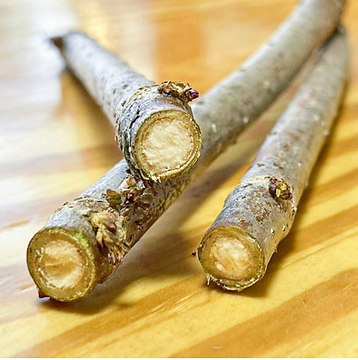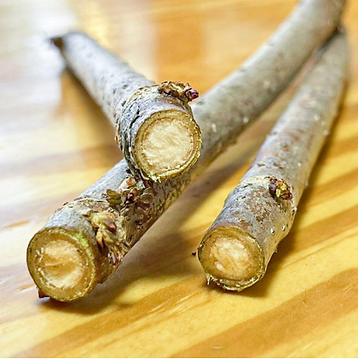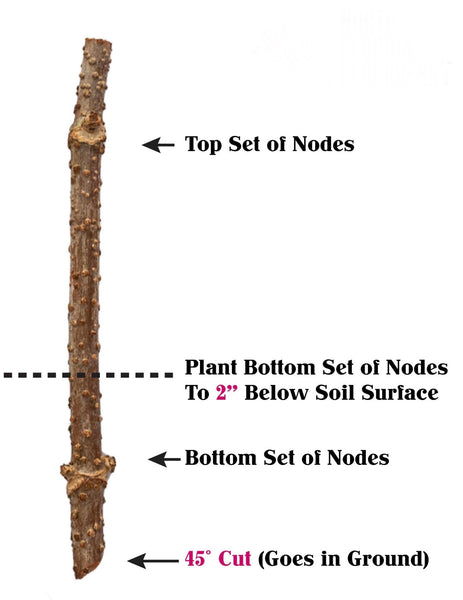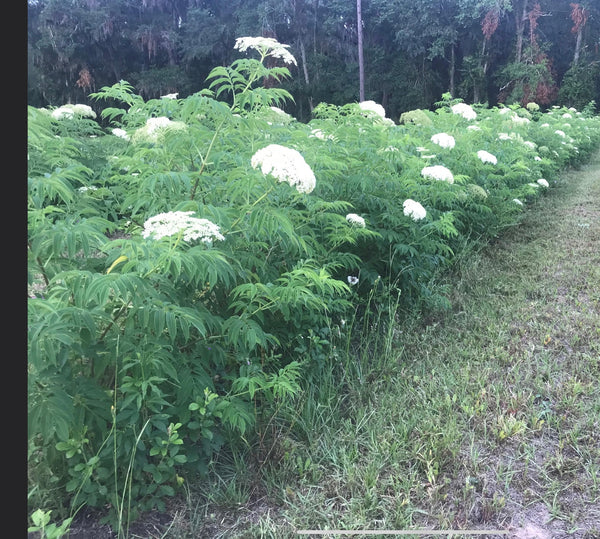2024 Elderberry Cuttings Sambucus Canadensis (6 cuttings)
ABOUT YOUR CUTTINGS:
Six (6) vibrant and robust cuttings similar to the Ranch variety, but even more robust - waiting to explode out of your garden.
Indeterminate with multiple berry flushes through the season.
Elderberry cuttings from Mr Dirtfarmer are Northeast Florida all American elderberry cuttings. I have some on the property with trunks as big as my arm.
Cuttings will be shipped in bags with moist sphagnum moss, also sourced locally. You may keep cuttings in your refrigerator until you're ready to plant. Don't wait too long.
About American elderberries, Sambucus canadensis:
In general, elderberries can reach around 15' tall in the South.
They thrive and produce the most in full sun but can grow well in part shade.
Elderberries are going to prefer a soil pH between 5.5 and 7.5.
They prefer a moist soil with lots of organic material. It is not required to have two different varieties to pollinate.
Elderberry Growing & Harvesting
Dormant Hardwood-Cutting Care & Planting Instructions
The elderberry is a very resilient plant and will grow almost anywhere, from Canada to the Gulf coast. The plants like water and can tolerate having their roots wet for a period of time. Though they will survive a drought, it is best to provide irrigation for maximum returns and highest plant health.
Dormant hardwood cuttings should be ordered in the fall. They will be shipped in late winter. The cuttings will hold in the refrigerator until planting time around the frost-free date.
Planting sticks while they are dormant is best. When the soil has thawed and days begin to warm, plant sticks directly into a prepared location, covered in the next section.
Dormant hardwood cuttings have an angle cut on the bottom end. Above the angle is a bud set. Put this bud set about two inches under the soil surface. The bottom buds will make roots and the top buds will make leaves. This will happen slowly but surely. Sometimes later in the year the top leaves will fall off if the plants are stressed; this means new shoots are preparing to emerge from under the soil surface.
Do not prune until the second winter.
Elderberries require a great deal of water, so make sure your chosen site has access to water. Mulch is suggested for weed control and to help retain moisture levels. Elderberries love nutrients, so plan to fertilize liberally with organic fertilizer.
Some growers will want to start cuttings indoors. Begin with the best soil possible. Insert dormant cutting into soil as described above and place the pot in a sunny and cool location. If the location is too warm, the cutting will grow leaves before it grows roots, causing weakness. Do not let the soil get dry.
Rooted cuttings should be planted slightly below the collar and the soil tamped. They should be grown in the greenhouse for 10-12 weeks before field planting.
New plantings need .5” to 1” of water per week. Elderberry plants are shallow rooted; thus, moisture and nutrients are received in the top few inches of soil.
Nitrogen should be applied 4 to 6 weeks after planting at a rate of 10 to 15 lbs per acre.Yearly application of on mature stand should be applied in late February or March at a rate of 50 to 75 lbs per acre. Organic compost should be applied every year to keep soil life optimized. Dehydrated chicken manure should be applied in late fall, or, if that window of opportunity is passed, in early spring.
May to early June, apply additional nitrogen, up to 15 lbs per acre.
Field Preparation and Plant Spacing
In fall or early spring, get soil samples tested and prepare beds accordingly.
“Pre-plant soil testing is recommended to evaluate the soil pH and nutrient levels. Adjust pH level to 5.5-6.5, phosphorus level to 50 lbs/acre, and potassium level to 200-300 lbs/acre. Although elderberry tolerates cold temperatures following bud break, it is best to select sites that are elevated relative to surrounding land to reduce the risk of damage from spring frost, i.e. which allows air drainage.
Elderberry requires full sun for optimum protection. Control problem perennial weeds such as Bermuda grass, Johnson grass, blackberry, and poison ivy before planting elderberry. Establish a non-competitive ground cover in the alleys between rows to facilitate operations in the planting. Elderberry is a freestanding bush and does not need trellising.
Create rows that are 12’ apart. This allows equipment to move between rows and give plants full sun. Lanes between rows are grass and will require mowing. Dormant cuttings or rooted cuttings should be set 2 to 4 feet apart.
New elderberry plantings need good weed control, as they do not compete well. Plant through a plastic or weed barrier membrane, and mulch heavily.
Water requirements are one inch per week during the growing season and more during drought and fruit ripening.
End of Season Fruit and Pruning Information
Fruiting mainly occurs on the terminal portion of one and two-year canes. Selective pruning results in a longer period of harvest and many more clusters.
Berries ripen from green to red to black with a hint of purple. They ripen over a period of 6-8 weeks achieving a size of 3/16 to ¼ inch. The entire cluster is cut off at harvest. Follow harvesting instructions to preserve quality. After harvest, one of three pruning methods is recommended: 1) selectively remove dead and undesirable canes each year; 2) remove all canes near ground level every other year; 3) remove all canes annually near ground level when the plant is dormant.
Removing all canes spurs vigorous new growth and results in a shorter window for fruit ripening. Older canes produce fewer fruit clusters, but those produced are larger.







